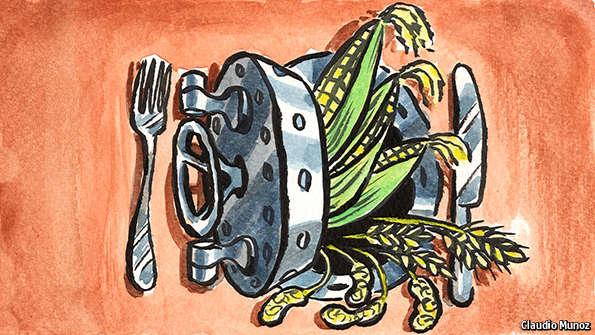
The Economist
FARMING is more efficient than ever. But the search for high yields has also made it more concentrated. From the wheat in steaming noodles to the maize of fresh tortillas, just 30 crops now sate almost all of humanity’s nutritional needs.
But monoculture carries great risks. A single disease or pest can wipe out swathes of the world’s food production, an alarming prospect given that its growing and wealthier population will eat 70% more by 2050 (see article). The risks are magnified by the changing climate. As the planet warms and monsoon rains intensify, farmlands in Asia will flood. North America will suffer more intense droughts, and crop diseases will spread to new latitudes. Pests are on the move, too. Since the 1960s, unwanted beasties, spared harsh winter frosts, have moved polewards at an average of around 3km (2 miles) a year.
The solutions to some of these problems lie in the genes of wild relatives of food crops. Botanists can screen them for valuable traits, and use the genes to breed new domestic varieties. Asian paddy fields were saved from the brown planthopper 40 years ago thanks to one wild Indian rice species. This is often cheaper and less controversial than genetic modification. But success depends on having thousands of varieties to test.
The burden of preserving biodiversity must fall on governments. Biotech firms focus on just a few commercial crops, and control the distribution of their seeds. Developing and maintaining seed banks, which currently hold 7.4m samples of the Earth’s bounty in their vaults, is essential. But most seed banks were built in the 1970s and 1980s and have seen little investment since. Some have disappeared altogether owing to war, as in Afghanistan, and fire, as in the Philippines. And keeping samples healthy requires regular propagation, not just dehydration and freezing. That means hiring and training plenty of botanists—who can also search for new species.
The world’s seed banks co-ordinate their work through the International Seed Treaty, which came into effect in 2004 and has been signed by 135 countries and the European Union. It identifies 35 food crops as so essential to global food security that their genetic diversity should be shared widely.
But some countries’ regulations on “biopiracy”—the uncompensated commercialisation of plants and seeds—stop the treaty from being properly implemented. In the 19th century rubber barons enriched themselves by sneaking seeds out of the Amazon. One explorer, Sir Henry Wickham, got 70,000 of them through customs; many were used to establish rubber plantations in Asia, breaking Brazil’s monopoly. India, among others, now offends too far the other way. Scientists working there struggle to get permission to export samples, even when they cite the treaty’s provisions, for fear of piracy. And the list of 35 essential crops fails to include some important ones, such as soyabeans and peanuts. It needs to be expanded.
Money well spent
Much harm has been done. In the past century about three-quarters of global crop genetic diversity is thought to have been lost, and with it many potentially beneficial traits. Preserving what remains is an insurance policy against the effects of climate change: Britain’s Millennium Seed Bank, the world’s largest, cost £73m ($112m) to complete in 2010. The damage from the brown planthopper came to $1 billion in today’s money. Governments should share species and fund seed banks. Their work is a vital safeguard against hunger.
No comments:
Post a Comment